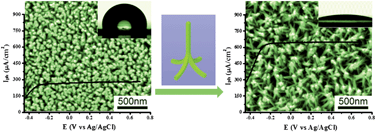In this work, we report a facile and environmentally friendly hydrothermal route to directly grow nanostructured TiO2 arrays on cheap titanium metal foil with tunable surface morphologies without using any catalysts, seeds or templates. Their crystal structure and morphology were characterized by powder X-ray diffraction, scanning electron microscopy, transmission electron microscopy and fast Fourier transform (FFT). The rutile TiO2 nanoarrays, growing along the [001] direction, consist of highly ordered nanowires (nanorods) rooting at the titanium substrate. The controlled growth of nanoarray films with different nanostructures, including nanowires, nanorods and nanocolumns, can be achieved by adjusting the key experimental parameters, such as growth time, reaction temperature and HCl concentration. Subsequently, the surface morphologies and wettability can be readily tuned. A possible growth mechanism is proposed based on a series of pieces of experimental evidence. The photoelectrochemical properties of the as-prepared rutile nanoarray films were investigated in detail. The photocurrent seems related to the surface morphology of the examined photoanode.

You have access to this article
 Please wait while we load your content...
Something went wrong. Try again?
Please wait while we load your content...
Something went wrong. Try again?


 Please wait while we load your content...
Please wait while we load your content...